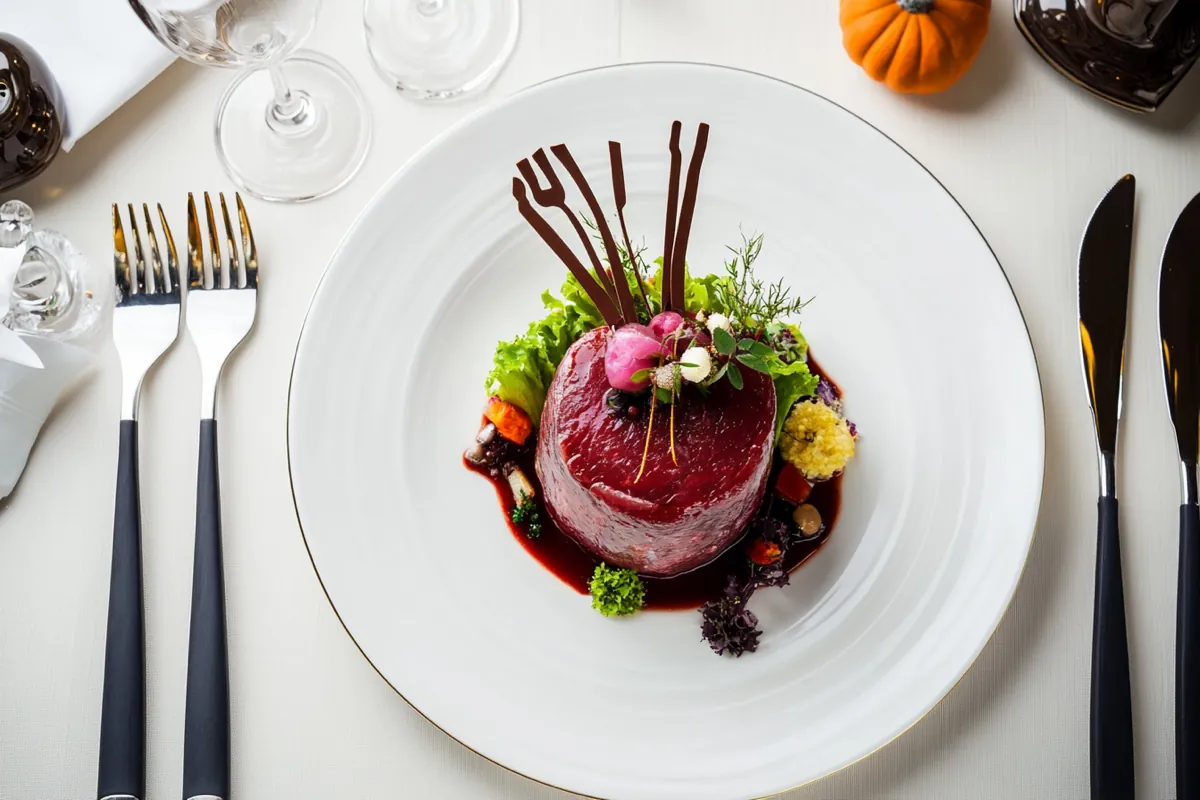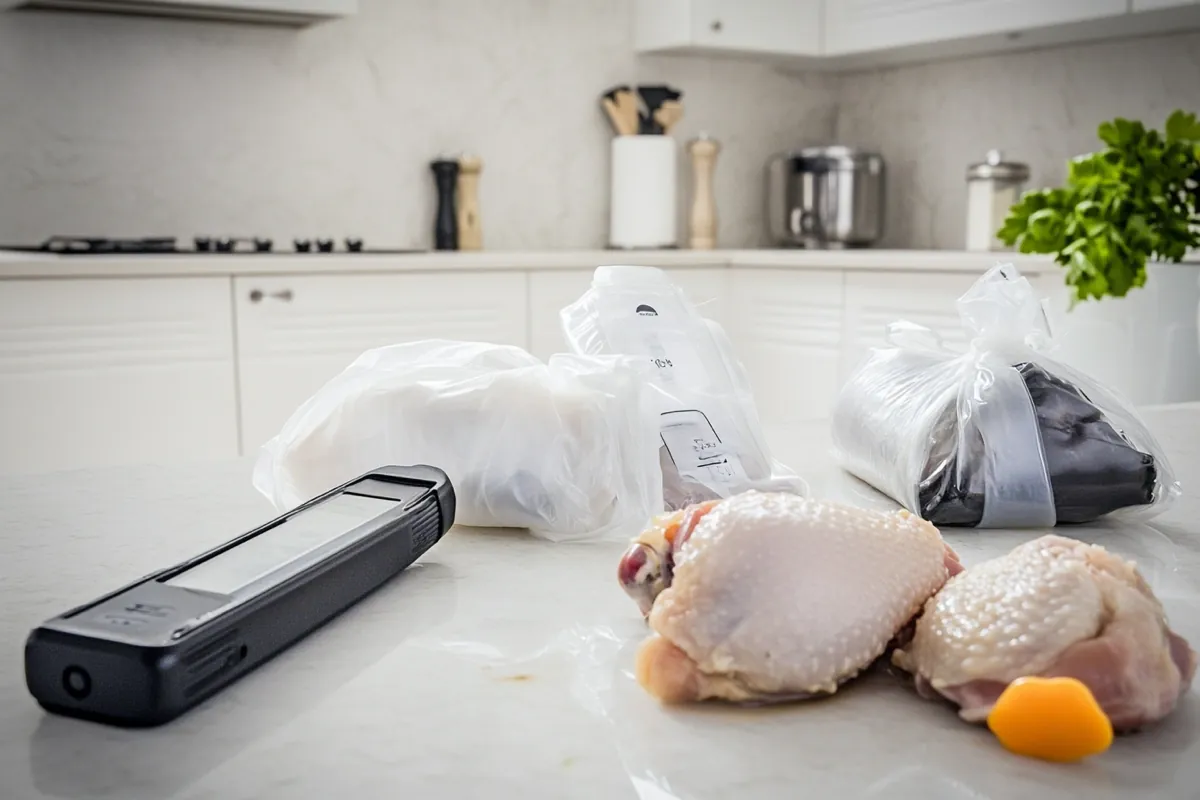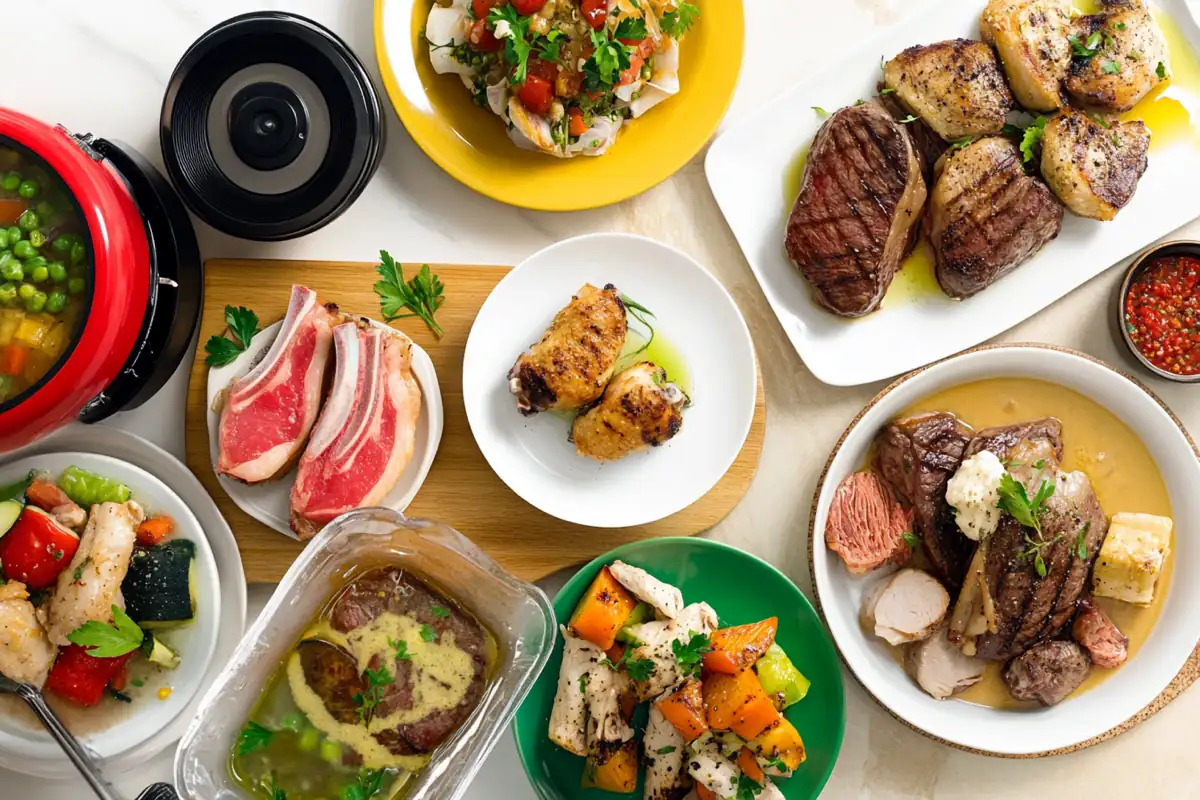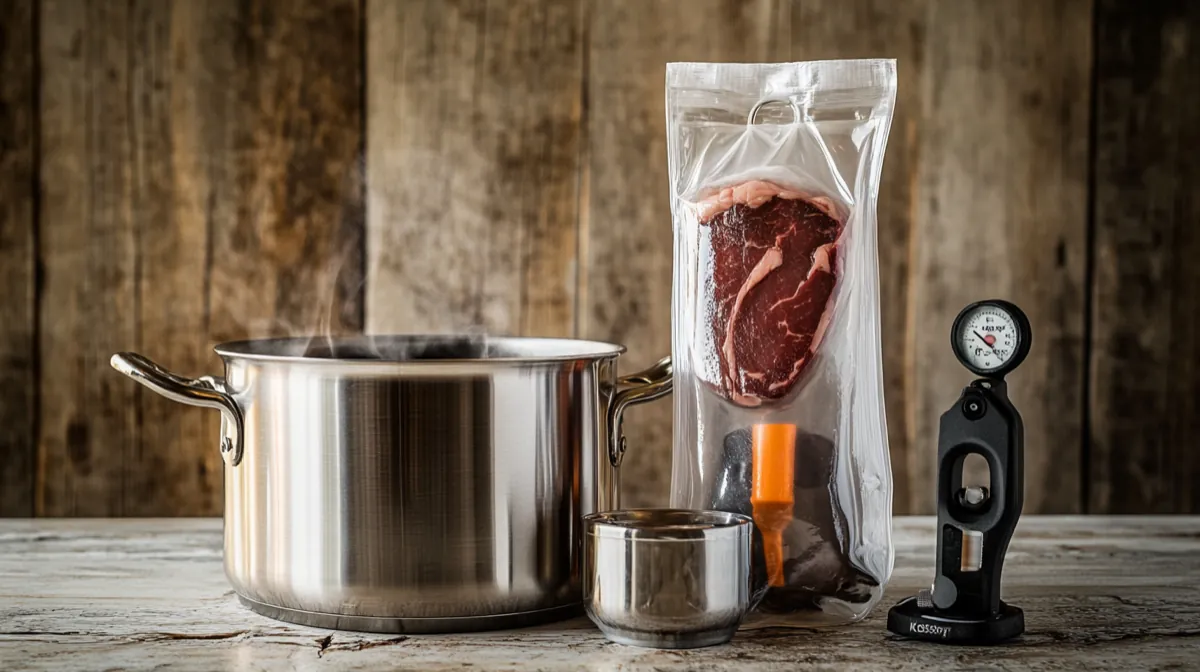Sous vide cooking has taken the culinary world by storm, offering a unique way to prepare meals. However, many home cooks are still unsure about using frozen ingredients. This guide explores the benefits and techniques of sous vide from frozen, ensuring you can create delicious meals with minimal effort. Whether you want to elevate your steak game or cook chicken to perfection, this article will help you master sous vide cooking while using frozen ingredients.
Table of Contents
Introduction to Sous Vide from Frozen
Sous vide, a French term meaning “under vacuum,” involves cooking food in a temperature-controlled water bath. This method allows for precise cooking, ensuring your meals reach the perfect doneness without the risk of overcooking. You might wonder why freezing your food first is beneficial. The answer lies in convenience and flavor.
When you cook from frozen, you save time. For instance, you can take the meal straight from the freezer to the water bath without the need to thaw. This not only simplifies meal prep but also retains moisture and flavor, making your dishes even more delicious. Additionally, cooking from frozen can enhance the texture of proteins, providing a tender and juicy result.
What is Sous Vide?
Sous vide is a cooking technique that involves sealing food in a vacuum-sealed bag and immersing it in a water bath heated to a specific temperature. This method allows food to cook evenly and retain moisture, making it ideal for meats, fish, and vegetables. The precise temperature control means you can achieve your desired doneness every time.
The magic of sous vide lies in its ability to transform frozen food. When you cook sous vide from frozen, you can skip the thawing process. This means you can prepare meals on a whim without worrying about planning ahead. The result? Perfectly cooked meals that are ready to serve whenever you are.
Benefits of Cooking Sous Vide from Frozen
Cooking sous vide from frozen comes with various benefits that can enhance your cooking experience.
Time Efficiency
One of the primary advantages of cooking from frozen is the time saved in meal preparation. You can directly place frozen ingredients into the water bath, eliminating the need for thawing. This is particularly useful for busy individuals or families who want to enjoy home-cooked meals without spending hours in the kitchen.
Enhanced Flavor and Texture
Cooking sous vide allows your ingredients to develop rich flavors. By cooking from frozen, you lock in moisture and flavors, resulting in a more succulent dish. The gentle cooking process also ensures that proteins maintain their natural tenderness. Whether it’s sous vide from frozen steak or sous vide frozen filet mignon, you’ll experience an elevation in taste and texture that traditional cooking methods may not provide.
Sous Vide from Frozen Steak: A Perfect Cut
When it comes to cooking steak, sous vide is an excellent method to achieve perfectly cooked meat. Cooking from frozen might sound unconventional, but it opens up a world of flavor and convenience.
Choosing the Right Steak for Sous Vide Cooking
Choosing the appropriate cut of steak is crucial for excellent results. Not all steaks are created equal. Some cuts lend themselves better to sous vide cooking, particularly when frozen.
Best Cuts for Sous Vide from Frozen Steak
For sous vide from frozen steak, consider cuts such as ribeye, sirloin, or tenderloin. These cuts have enough fat marbling to maintain flavor and tenderness during the cooking process. Ribeye, for example, offers a rich flavor and juicy texture that elevates your dish to a gourmet experience.
Thawing vs. Cooking from Frozen
Many cooks wonder whether they should thaw their steak before cooking. The beauty of sous vide is that you can cook from frozen without sacrificing quality. In fact, cooking directly from frozen can result in a more tender and juicy steak. The sous vide method ensures even cooking, so your steak will be perfectly done, regardless of whether it started frozen or thawed.
Cooking Techniques for Sous Vide from Frozen Steak
Now that you have the right steak, it’s time to explore how to cook it sous vide.
Ideal Temperature and Time Guidelines
For sous vide from frozen steak, the ideal cooking temperature depends on your desired doneness. Here are some guidelines:
- Rare: 120°F (49°C) for 1.5 to 4 hours
- Medium Rare: 130°F (54°C) for 1.5 to 4 hours
- **Medium

Sous Vide Frozen Filet Mignon: Elevate Your Dinner
Filet mignon is one of the most luxurious cuts of beef, and when cooked sous vide from frozen, it can be an extraordinary dining experience. The tenderness and rich flavor of this cut make it a favorite among meat lovers.
Selecting Filet Mignon for Sous Vide Cooking
When choosing filet mignon for sous vide cooking, quality is key. You want a cut that is tender and well-marbled, which enhances the flavor and texture.
Quality Considerations
Look for filet mignon that has a bright red color with a good amount of marbling. This marbling is essential for ensuring that the meat remains juicy and flavorful during the cooking process. Avoid any cuts that appear dry or discolored, as these may not deliver the best results.
Packaging and Freezing Tips
To ensure the best results when cooking sous vide from frozen, proper packaging is crucial. Vacuum-seal the filet mignon or use a freezer-safe zip-lock bag, ensuring all air is removed. This prevents freezer burn and helps maintain the quality of the meat. When freezing, label the bags with the date and cut for easy identification.
Perfect Cooking Method for Sous Vide Frozen Filet Mignon
Cooking filet mignon sous vide is straightforward, but attention to detail is vital to achieving the perfect steak.
Recommended Cooking Times and Temperatures
For sous vide frozen filet mignon, follow these cooking temperature guidelines based on your preferred doneness:
- Rare: 120°F (49°C) for 1.5 to 4 hours
- Medium Rare: 130°F (54°C) for 1.5 to 4 hours
- Medium: 140°F (60°C) for 1.5 to 4 hours
- Medium Well: 150°F (66°C) for 1.5 to 4 hours
The beauty of sous vide is the flexibility in cooking time. The steak will not overcook, so you can adjust the time based on your schedule.
Plating and Serving Suggestions
After cooking your filet mignon, it’s time to elevate your presentation. Start by searing the steak in a hot pan for about 1-2 minutes on each side to create a beautiful crust. Let the steak rest for a few minutes before slicing.
Serve it with sides like garlic mashed potatoes or sautéed asparagus. For an extra touch, drizzle a balsamic reduction or herb butter over the top. This not only enhances the flavor but also adds an appealing visual element to your dish.
Sous Vide from Frozen Chicken: A Juicy Delight
Chicken is a versatile protein that can be transformed into a delicious meal using sous vide from frozen. The gentle cooking process ensures that your chicken remains moist and tender, making it a favorite for families and home cooks.
Types of Chicken Suitable for Sous Vide
When deciding to cook chicken sous vide, consider the cut. Different parts of the chicken offer various flavors and textures.
Whole Chicken vs. Chicken Breasts
Whole chickens are great for feeding a crowd, while chicken breasts are perfect for quick meals. When cooking from frozen, chicken breasts are particularly convenient, as they cook evenly and quickly in the sous vide bath.
Marinades and Seasoning Tips
To enhance the flavor of your chicken, marinating is a wonderful option. Use simple marinades with ingredients like olive oil, lemon juice, garlic, and herbs. For the best results, marinate your chicken for at least 30 minutes before sealing it in the vacuum bag. However, if you’re in a hurry, you can also add the marinade directly into the vacuum-sealed bag before freezing.
Cooking Frozen Chicken Sous Vide: Step-by-Step
Now that you have your chicken ready, here’s how to cook it sous vide.
Temperature and Timing Guide
For sous vide from frozen chicken, use the following temperature guidelines based on your desired outcome:
- Chicken Breasts: 140°F (60°C) for 1-4 hours
- Thighs: 165°F (74°C) for 1-4 hours
- Whole Chicken: 150°F (65°C) for 4-6 hours
The longer cooking times will ensure that the chicken remains tender and juicy, while the precise temperatures prevent overcooking.

Safety Considerations When Sous Vide from Frozen
While sous vide cooking is a fantastic method for preparing meals, it’s essential to follow safety guidelines, especially when cooking from frozen. Understanding food safety will ensure that your meals are not only delicious but also safe to eat.
Understanding Sous Vide Safety Protocols
Sous vide cooking is safe when done correctly, but there are key protocols you must follow to minimize risks.
The Importance of Temperature Control
Maintaining the right temperature is crucial in sous vide cooking. The USDA recommends cooking chicken at 165°F (74°C) to ensure any harmful bacteria are killed. However, when cooking at lower temperatures, like 140°F (60°C), you need to extend the cooking time to ensure the chicken is safe to eat. This is because the longer the chicken is held at a lower temperature, the more bacteria are eliminated.
Avoiding Bacterial Growth
Using proper vacuum sealing techniques is vital. Make sure to remove as much air as possible from your vacuum-sealed bags. This not only helps in cooking evenly but also prevents bacterial growth. If you’re cooking from frozen, ensure that the bags are sealed airtight to avoid any contamination.
Common Mistakes to Avoid
Avoiding common pitfalls can enhance your sous vide experience and ensure food safety.
Overcooking and Undercooking Risks
One of the most significant benefits of sous vide is the precision it offers, but it’s easy to get the timing wrong. While sous vide cooking is forgiving, it’s essential not to leave food in the water bath for too long. For example, cooking filet mignon for more than four hours can lead to a mushy texture. Always refer to time and temperature guidelines to avoid overcooking.
Using Proper Equipment
Investing in quality sous vide equipment is crucial. A reliable immersion circulator ensures you maintain consistent water temperature. Additionally, using high-quality vacuum-sealed bags designed for sous vide cooking is essential. Regular plastic bags may not withstand the heat, leading to leaks and potential food safety issues.
Comparing Sous Vide from Frozen vs. Fresh
Understanding the differences between cooking from frozen versus fresh ingredients can help you make better choices in the kitchen.
Flavor and Texture Differences
Cooking from frozen tends to yield different results compared to fresh. When you cook sous vide from frozen, the moisture is locked in right from the start. This can result in a juicier texture since the food doesn’t lose liquid as it cooks. On the other hand, fresh ingredients may have a slightly different texture due to the immediate cooking process.
Nutritional Value Comparison
Both frozen and fresh ingredients can be nutritious. However, freezing can help preserve nutrients. For instance, vegetables are often frozen shortly after harvesting, locking in their vitamins. When comparing sous vide from frozen chicken to fresh chicken, both can be equally healthy, depending on how they were handled prior to cooking.
Popular Sous Vide Recipes Using Frozen Ingredients
Now that you understand the benefits and safety guidelines, it’s time to explore some delicious recipes you can create using sous vide from frozen ingredients.
Sous Vide from Frozen Steak Recipe
Cooking steak sous vide from frozen is simple and rewarding. Here’s a quick recipe to get you started.
Ingredients and Preparation Steps
- 1 frozen ribeye steak
- Salt and pepper
- Garlic powder (optional)
- Fresh herbs (optional)
- Season the frozen steak generously with salt, pepper, and garlic powder.
- Vacuum seal the steak in a sous vide bag or use a zip-lock bag with the water displacement method.
- Set your sous vide immersion circulator to the desired temperature based on your preferred doneness.
Cooking Instructions
- Place the vacuum-sealed steak in the preheated water bath.
- Cook for 1.5 to 4 hours, depending on your desired doneness.
- Once finished, remove the steak from the bag and pat dry.
- Sear in a hot pan for 1-2 minutes on each side for a perfect crust.
- Serve with your favorite sides.
Sous Vide Frozen Filet Mignon Recipe
Elevate your dinner with this elegant filet mignon recipe.
Ingredients and Preparation Steps
- 1 frozen filet mignon
- Salt and pepper
- Olive oil
- Fresh thyme or rosemary (optional)
- Season and Seal: Season the frozen filet mignon with salt and pepper. Add a drizzle of olive oil and a sprig of thyme or rosemary (if using) into the vacuum bag. Vacuum seal the steak tightly to remove all air.
- Set Sous Vide Temperature: Preheat your sous vide water bath to 130°F (54°C) for medium-rare or adjust to your preferred doneness.
- Cook: Submerge the vacuum-sealed filet mignon in the water bath and cook for 2–2.5 hours. Cooking from frozen ensures even heating and a perfectly tender result.
- Remove and Pat Dry: After cooking, take the filet mignon out of the bag and pat it dry with paper towels to prepare it for searing.
- Sear for Perfection: Heat a skillet over high heat with a bit of olive oil or butter. Sear the filet mignon for 1–2 minutes on each side until it forms a golden-brown crust.
- Rest and Serve: Let the steak rest for 5 minutes before slicing or serving. Pair with your favorite sides, such as mashed potatoes or roasted vegetables, for an elegant meal.
Enjoy a perfectly cooked filet mignon, tender and full of flavor!

Conclusion: Mastering Sous Vide from Frozen
In conclusion, sous vide from frozen opens up a world of cooking possibilities. It allows for convenient meal preparation while ensuring that your proteins are cooked to perfection. Whether you’re preparing sous vide from frozen steak, sous vide frozen filet mignon, or sous vide from frozen chicken, the results are consistent, flavorful, and tender.
Recap of Key Points
We’ve covered the essentials of sous vide cooking, including the benefits of cooking from frozen, safety protocols, and tasty recipes. Remember, the key to mastering sous vide is understanding temperature control and proper cooking times.
Encouragement to Experiment with Sous Vide
Don’t hesitate to experiment with different cuts and flavors. Sous vide cooking is adaptable, and the only limit is your creativity. With practice, you will become more comfortable with the process, leading to delicious meals your family and friends will love.
FAQ
As you embark on your sous vide cooking journey, you may have several questions. Here are some frequently asked questions about sous vide from frozen, along with their answers.
Can You Sous Vide Directly from Frozen?
Yes, you can sous vide directly from frozen. In fact, one of the great advantages of sous vide cooking is that you can cook frozen ingredients without thawing. This method saves time and preserves flavor and moisture, resulting in tender and juicy dishes.
How Much Longer to Sous Vide from Frozen?
Generally, cooking from frozen takes a bit longer than cooking fresh. You can expect to add about 30 minutes to an hour more to the cooking time, depending on the thickness of the meat. For example, a frozen steak might take 1.5 to 4 hours, while a fresh one usually requires a similar range but can often be on the shorter end.
Is It OK to Sous Vide Frozen Chicken?
Absolutely! Sous vide is a safe method for cooking frozen chicken. Just ensure that you follow the correct temperature and time guidelines to eliminate any harmful bacteria. Cooking chicken at 165°F (74°C) will ensure it’s safe to eat.
Can You Sous Vide a Roast from Frozen?
Yes, you can sous vide a roast from frozen. Just like with chicken and steak, ensure you adjust the cooking time accordingly. Roasts will typically take longer than smaller cuts of meat, so plan for additional cooking time based on the size and thickness of the cut.
What Are the Risks of Sous Vide from Frozen?
While sous vide cooking from frozen is generally safe, you must follow food safety guidelines. The main risks involve not cooking at the proper temperatures or for sufficient durations, which can lead to foodborne illnesses. Always use a reliable sous vide machine to ensure consistent temperatures and avoid using improper packaging.




